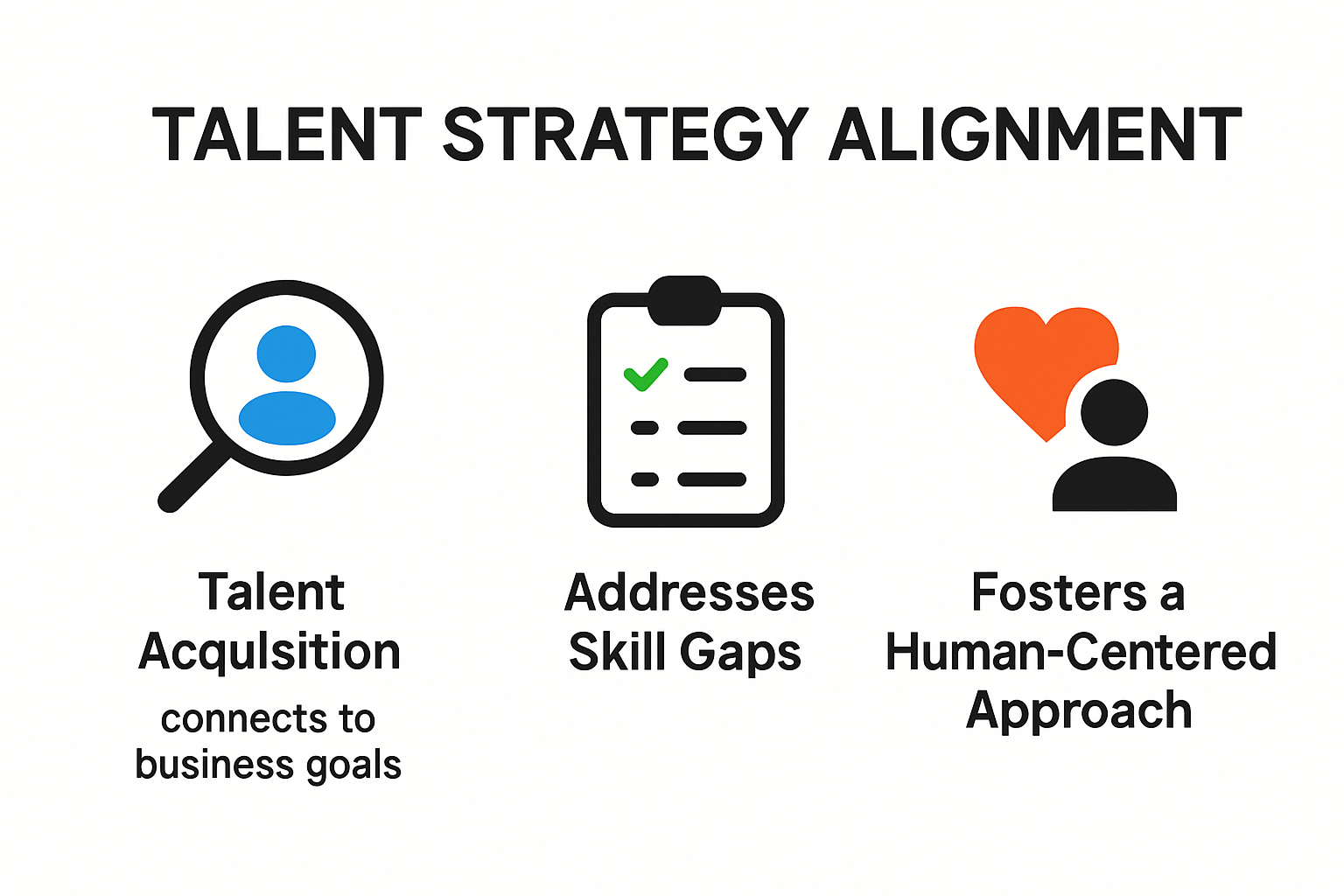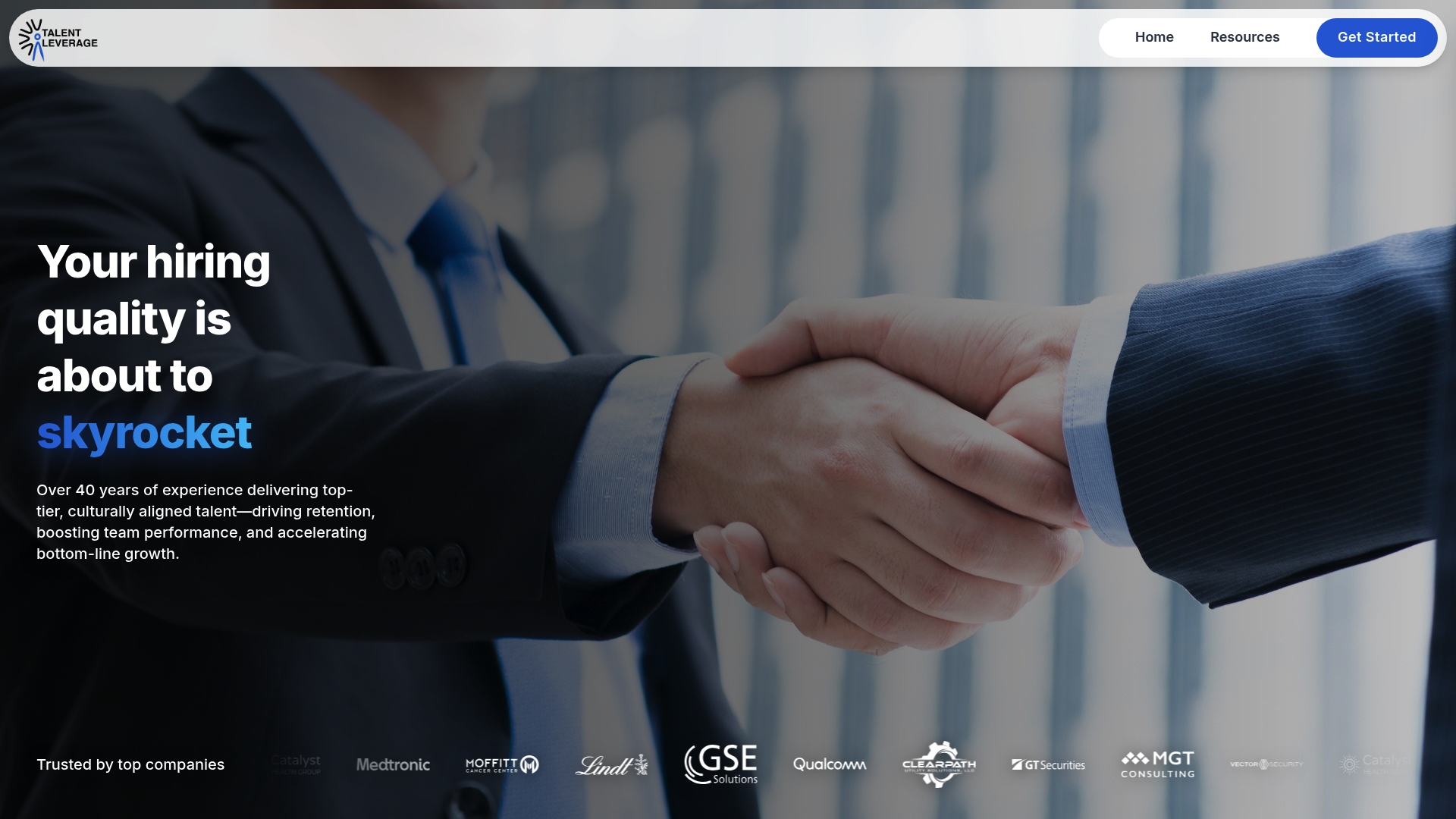
Talent strategy alignment for 2025 is facing a wake-up call. Almost every company claims to prioritize people, yet only 15 percent of business leaders feel fully confident in their hiring decisions. Surprised? Most organizations are scrambling to fill skill gaps while navigating a talent market where recruiters juggle 85 percent more hires per month than the global average. The real twist is that those who approach recruiting as a strategic partnership—connecting every hire to business goals, not just an open seat—are set to outperform everyone else.
Table of Contents
- Why Talent Strategy Alignment Matters In 2025
- Connecting Hiring Plans To Business Goals
- Key Challenges For US Industry Leaders
- Best Practices For Regional Talent Strategy Alignment
Quick Summary
| Takeaway | Explanation |
|---|---|
| Talent Strategy Alignment is Essential | Organizations must prioritize strategic alignment of talent acquisition with business goals to survive in 2025’s competitive landscape. |
| Proactive Skills Management | Companies should anticipate skill evolution and invest in upskilling and reskilling to close the growing skills gap. |
| Data-Driven Recruitment Decisions | Leveraging workforce analytics enables organizations to make predictive talent decisions, enhancing hiring efficiency and strategic alignment. |
| Create a Talent Ecosystem | Build a seamless integration of hiring, development, and retention strategies to view new hires as long-term strategic partners rather than temporary solutions. |
| Address Confidence Crisis in Hiring | Overcome uncertainty in hiring decisions by adopting innovative recruitment strategies and utilizing technology to improve confidence levels among organizational leaders. |
Why Talent Strategy Alignment Matters in 2025
The talent landscape of 2025 demands a radical reimagining of how organizations approach workforce strategy. Companies can no longer view talent acquisition as a transactional process but must transform it into a strategic alignment that bridges organizational goals with human potential.

The Shifting Dynamics of Talent Acquisition
In a rapidly evolving job market, talent strategy alignment has become more than a competitive advantage—it is now a survival imperative. Explore our talent acquisition insights to understand the critical shifts happening in recruitment. According to data from JobSpikr, organizations that fail to prioritize strategic talent alignment risk losing their most valuable asset: their people.
The numbers tell a compelling story. U.S. recruiters currently face a low offer acceptance rate of 79%, indicating significant misalignment between candidate expectations and organizational approaches. This statistic underscores the urgent need for a more nuanced, relationship-driven talent strategy that goes beyond traditional recruiting methods.
Skills Gaps and Strategic Workforce Planning
The skills landscape is transforming at an unprecedented pace. Research from Escoffier Global reveals a stark reality: 76% of U.S. organizations struggled to find qualified candidates for positions requiring new skills in the past year. This skills gap is not just a recruitment challenge—it represents a fundamental disconnect between workforce capabilities and organizational needs.
Successful talent strategy alignment in 2025 requires a proactive approach. Companies must:
- Anticipate Skill Evolution: Continuously map emerging skills against future business requirements.
- Develop Internal Talent Pipelines: Create robust upskilling and reskilling programs.
- Embrace Flexible Workforce Models: Integrate contract, full-time, and specialized talent seamlessly.
The Human-Centered Approach to Talent Strategy
Beyond technical skills, talent strategy alignment demands a profound understanding of human potential. It is about creating environments where talented professionals can thrive, grow, and contribute meaningfully. Our guide on redefining successful hiring illustrates how forward-thinking organizations are reimagining talent acquisition.
The most successful companies in 2025 will be those that view talent not as a resource to be managed, but as strategic partners in organizational growth. This means developing holistic strategies that address candidate experience, professional development, cultural fit, and long-term career trajectories.
Talent strategy alignment is no longer optional—it is the cornerstone of organizational resilience and competitive advantage in an increasingly complex global marketplace.
Connecting Hiring Plans to Business Goals
Effective talent strategy alignment demands more than traditional recruitment approaches. Organizations must transform hiring from a reactive process to a strategic blueprint that directly supports broader business objectives.

Strategic Workforce Planning as a Competitive Advantage
In 2025, successful companies recognize that hiring is not just about filling positions but about creating a talent ecosystem that drives organizational growth. Learn how to streamline your hiring process to ensure precision alignment with business goals.
According to Korn Ferry, talent acquisition strategies must now leverage advanced analytics and AI to create responsive hiring frameworks. This means developing predictive models that anticipate skill requirements, potential talent gaps, and workforce dynamics before they become critical challenges.
The data underscores this imperative. U.S. recruiters are now managing an average of 54 hires per month—85% higher than the global average—which demands unprecedented strategic sophistication. Each hire represents not just a personnel decision, but a potential catalyst for organizational transformation.
Aligning Talent Acquisition with Organizational Vision
Connecting hiring plans to business goals requires a multifaceted approach. Key strategies include:
- Predictive Workforce Analytics: Utilize data-driven insights to forecast talent needs
- Skill Mapping: Continuously align recruitment with emerging organizational capabilities
- Agile Talent Frameworks: Design flexible hiring models that can quickly adapt to changing business landscapes
Research from JobSpikr highlights that organizations leveraging workforce analytics are 3.2 times more likely to make strategic hiring decisions that directly contribute to business performance.
Beyond Recruitment: Creating a Talent Ecosystem
Modern talent strategy alignment transcends traditional recruitment metrics. It requires creating a holistic talent ecosystem where hiring, development, and retention are seamlessly integrated. This means viewing each new hire as a potential long-term strategic partner rather than a temporary resource.
Companies must develop comprehensive talent strategies that:
- Anticipate future skill requirements
- Create internal mobility pathways
- Design compensation and development programs that attract and retain top talent
The most successful organizations in 2025 will be those that view talent acquisition not as a cost center, but as a critical strategic investment. By meticulously connecting hiring plans to business goals, companies can build resilient, adaptive workforces capable of navigating complex market dynamics.
Talent is no longer just about filling roles—it’s about architecting the future of your organization, one strategic hire at a time.
Key Challenges for US Industry Leaders
The talent acquisition landscape in 2025 presents unprecedented challenges for U.S. industry leaders, demanding innovative strategies and a radical reimagining of traditional recruitment approaches.
Confidence Crisis in Hiring Decisions
A startling revelation from SmartRecruiters exposes a critical vulnerability in current hiring practices: only 15% of business leaders feel fully confident in their hiring decisions at the moment of selection. This confidence deficit represents a significant operational risk, with 60% of leaders expressing substantial doubt about their new hires.
The implications are profound. Uncertain hiring decisions can lead to:
- Reduced Organizational Performance: Misaligned talent can compromise team productivity
- Increased Turnover Costs: Frequent mismatches result in expensive recruitment cycles
- Strategic Execution Challenges: Uncertain talent capabilities disrupt long-term business planning
Technological Transformation and Human Complexity
Korn Ferry research reveals a nuanced technological challenge: while 67% of U.S. industry leaders see increased AI usage as a critical talent acquisition trend, 40% simultaneously worry that excessive technological intervention could make recruitment impersonal.
This technological paradox introduces critical considerations:
- Balancing AI efficiency with human intuition
- Preventing algorithmic bias in candidate selection
- Maintaining authentic candidate experiences
Particularly concerning is the 25% of leaders worried about algorithmic bias potentially compromising hiring fairness—a legitimate concern that demands sophisticated, ethical technological implementation.
Performance and Goal Achievement Gaps
Productivity challenges extend beyond hiring decisions. Good Time’s research unveils a stark reality: U.S. talent acquisition teams achieved merely 47.9% of their hiring goals in 2024—the lowest rate in four years. The manufacturing sector performed worst, attaining just 36% of its hiring objectives.
These performance gaps stem from multiple interconnected challenges:
- Prolonged scheduling processes
- Communication inefficiencies
- Increasing time-to-hire metrics
- Complex skill requirement landscapes
Industry leaders must recognize that these challenges are not isolated issues but interconnected systemic problems requiring holistic, strategic interventions. Success in 2025 demands adaptive, intelligent approaches that blend technological innovation with deep human understanding.
The most successful organizations will be those that transform these challenges into opportunities—creating resilient, dynamic talent strategies that turn potential obstacles into competitive advantages.
Best Practices for Regional Talent Strategy Alignment
Regional talent strategy alignment has become a critical differentiator for organizations seeking to build robust, adaptable workforce capabilities in an increasingly competitive talent marketplace.
Strategic Partnerships and Ecosystem Development
Explore our talent acquisition solutions to understand the importance of creating comprehensive regional talent ecosystems. According to Gartner, Chief Human Resources Officers (CHROs) must now strategically align talent strategies with CEO growth priorities, delivering both current and emerging skills while developing transformation-ready leadership.
Successful regional talent strategies require building strong collaborative networks. This means developing intentional partnerships with:
- Local educational institutions
- Economic development organizations
- Workforce training programs
- Community leadership groups
Benchmarking and Adaptive Learning
Research from NYS Upstate Planning highlights the critical importance of benchmarking against national best practices while maintaining local context. Organizations must create adaptive talent strategies that can:
- Quickly respond to emerging skill requirements
- Integrate technological advancements
- Address specific regional workforce challenges
The Greater Rochester Chamber’s approach demonstrates how regional talent strategies can be effectively tailored. By integrating federally funded Tech Hub positions with existing workforce development programs, they create a more responsive and dynamic talent ecosystem.
Technology-Enabled Talent Alignment
In 2025, technology becomes a crucial enabler of regional talent strategy alignment. Our guide on successful hiring transformations illustrates how advanced technologies can bridge gaps between regional talent needs and organizational requirements.
Key technological considerations include:
- Advanced skills mapping platforms
- AI-driven talent prediction models
- Real-time labor market analytics
- Collaborative workforce development interfaces
Organizations that successfully implement these practices will create resilient, forward-looking talent strategies that not only meet current needs but anticipate future workforce transformations. Regional talent strategy alignment is no longer a theoretical concept—it is a practical necessity for businesses seeking to thrive in an increasingly complex and dynamic talent marketplace.
The future of talent acquisition belongs to those who can seamlessly integrate local insights, technological innovation, and strategic foresight into a cohesive, adaptive workforce development approach.
Frequently Asked Questions
What is talent strategy alignment?
Talent strategy alignment refers to the process of synchronizing an organization’s talent acquisition efforts with its overall business goals. This ensures that hiring decisions support long-term organizational success and address current and future skill needs.
Why is talent strategy alignment important for 2025?
As organizations face challenges in the evolving talent market, aligning hiring practices with business objectives is crucial for maintaining a competitive edge. It helps address skill gaps, improves recruitment efficiency, and enhances overall organizational performance.
How can companies identify skill gaps in their workforce?
Companies can identify skill gaps by conducting workforce assessments, analyzing industry trends, leveraging predictive analytics, and seeking feedback from current employees to map existing skills against future business requirements.
What role does technology play in talent strategy alignment?
Technology plays a significant role by enabling advanced analytics, automating recruitment processes, and facilitating data-driven decision-making. It helps organizations anticipate talent needs, improve hiring efficiency, and create a more responsive talent ecosystem.
Transform Your Talent Strategy: From Uncertainty to Competitive Success
Is your organization struggling to bridge the gap between big hiring goals and real-world results? If confidence in hiring decisions feels low and your team is grappling with skills gaps, know that you are not alone. As highlighted in this article, aligning talent strategy with your business vision unlocks a lasting advantage––whether you need advanced analytics, robust internal pipelines, or a stronger link between recruitment and organizational outcomes. Discover expert resources and best practices on our Resources – Talent Leverage page and see how leading companies take talent acquisition from guesswork to precision.

Ready to turn every hire into a strategic win for your business? Connect with Talent Leverage today at https://talentleverage.com. Explore how our relationship-first, industry-focused approach helps you boost recruiting outcomes, close skill gaps, and align every hire with your 2025 objectives. Don’t let uncertainty hold you back––seize this moment for transformative talent results.

